BIO-249 Lecture Exam 7: Membrane Potentials & The Nervous System
1/38
There's no tags or description
Looks like no tags are added yet.
Name | Mastery | Learn | Test | Matching | Spaced |
|---|
No study sessions yet.
39 Terms
What is the voltage & membrane potential?
Voltage:
measure of potential energy generated by separated electrical charges
measured in mV
Membrane Potential:
Relative DIFFERENCE in charge between the inside & outside of the cell
we can use this potential energy that’s held in the separation of charge across the cell membrane
charge of the inside - charge of the outside
What are the four most common ions that can contribute to a cell’s membrane potential?
For each of these ions, what is their charge?
Na+ : positive 1
K+: positive 1
Cl-: negative 1
Ca2+: positive 2
What is the electrochemical gradient for a given ion?
“chemical”: ions moving in and out of the cell due to their concentration gradient
INFLUENCES electrical gradient
focusing on the ion concentration
STRONGER than the electrical gradient
“electrical”: the charge gradient
focusing on all the ions and proteins (negative charge) inside and outside the cell
electrical gradient dictates HOW MANY ions should come back inside the cell
Describe how ions would move along the electrochemical gradient.
Channel Proteins
Leaky Channels (facilitated diffusion)
Na+ Channel
K+ Channel
Na+/K+ Exchanger (active transportation)
Uses ATP
[Na+]outside HIGH and [Na+]inside LOW
[K+]outside LOW and [K+]inside HIGH
ION MOVEMENT
Chemical Gradient
Na+ ions move DOWN their concentration gradient (move outside the cell)
Electrical gradient
There’s a difference in charges now
Outside: MORE POSITIVE
Inside: MORE NEGATIVE
Opposite charges attract → Na+ cations will move BACK into the cell
Summary
Chemical gradient pushes ions OUT, electrical gradient moves ions back INTO the cell
![<ul><li><p><strong>Channel Proteins</strong></p><ol><li><p><strong>Leaky Channels (facilitated diffusion)</strong></p><ol><li><p>Na+ Channel</p></li><li><p>K+ Channel</p></li></ol></li><li><p><strong>Na+/K+ Exchanger (active transportation)</strong></p><ul><li><p>Uses ATP</p></li><li><p>[Na<sup>+</sup>]<sub>outside</sub> HIGH and [Na<sup>+</sup>]<sub>inside</sub> LOW</p></li><li><p>[K<sup>+</sup>]<sub>outside</sub> LOW and [K<sup>+</sup>]<sub>inside</sub> HIGH</p></li></ul></li></ol></li></ul><p><strong>ION MOVEMENT</strong></p><ol><li><p><strong><mark data-color="purple" style="background-color: purple; color: inherit">Chemical Gradient</mark></strong></p><ul><li><p>Na<sup>+</sup> ions move DOWN their concentration gradient (move outside the cell)</p></li></ul></li><li><p><strong><mark data-color="purple" style="background-color: purple; color: inherit">Electrical gradient</mark></strong></p><ul><li><p>There’s a difference in charges now </p></li><li><p>Outside: MORE POSITIVE </p></li><li><p>Inside: MORE NEGATIVE</p></li><li><p>Opposite charges attract → Na+ cations will move BACK into the cell</p></li></ul></li><li><p>Summary</p><ul><li><p>Chemical gradient pushes ions OUT, electrical gradient moves ions back INTO the cell</p></li></ul></li></ol><p></p>](https://knowt-user-attachments.s3.amazonaws.com/95703e70-5c92-491d-b130-986fbeb96bf9.jpg)
What two factors determine the electrochemical gradient?
Concentration Gradient of Ions
Permeability (ability for ions to move across the cell membrane)
In a human cell, where is potassium ion (K) concentration the highest?
Where is the chloride ion (Cl) concentration the highest?
Where is Sodium (Na) concentration the highest?
K+
Highest: Inside the cell
Lowest: Outside the cell
Cl-
Highest: Outside the cell
Lowest: Inside the cell
Na+
Highest: Outside
Lowest: Inside
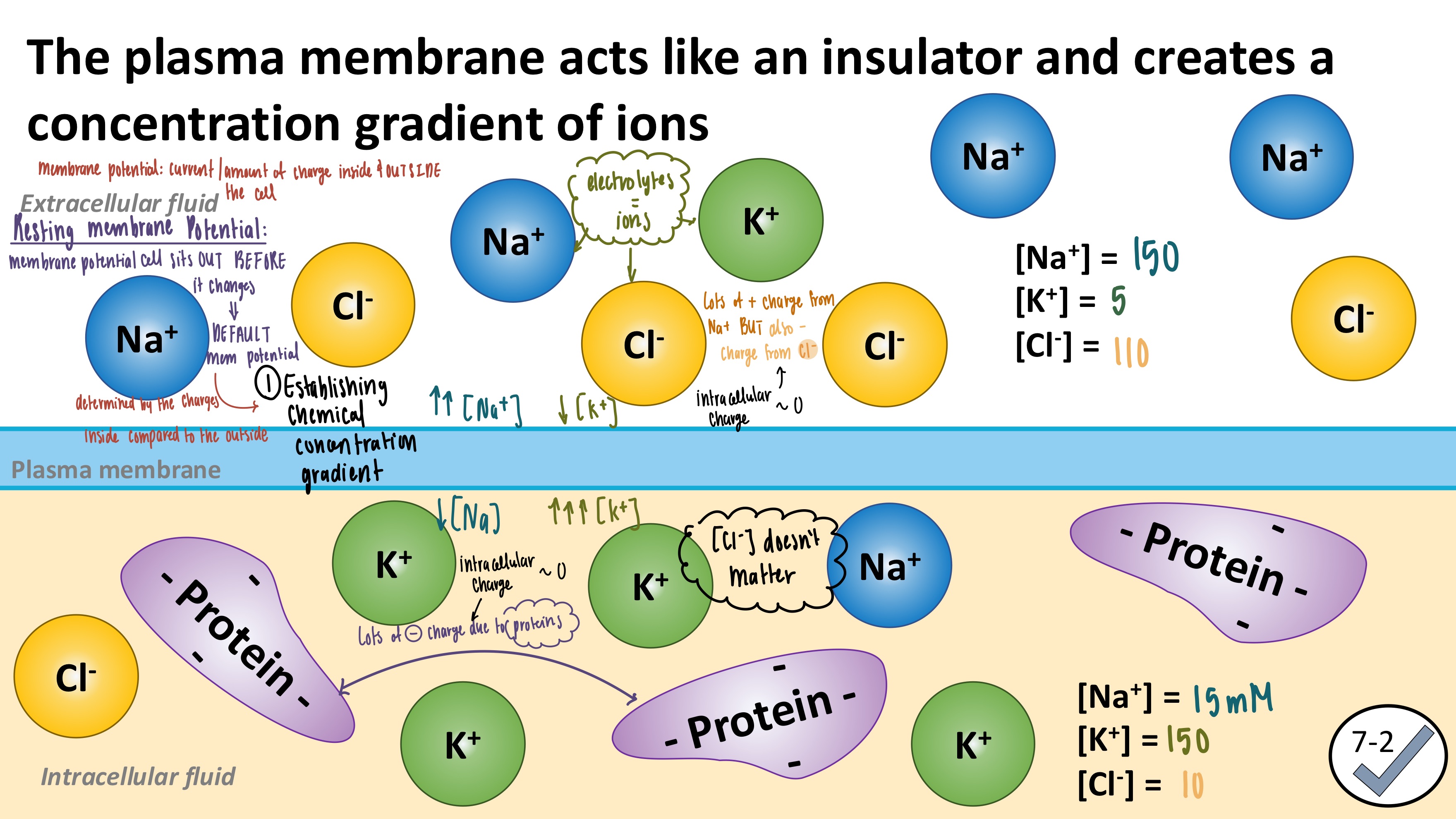
Are the intracellular fluid (ICF) and extracellular fluid (ECF) themselves electrically neutral?
YES
Intracellular Fluid
Negative charge: proteins
Positive charge: K+ ions
Extracellular Fluid
Negative Charge: Cl-
Positive Charge: Na+
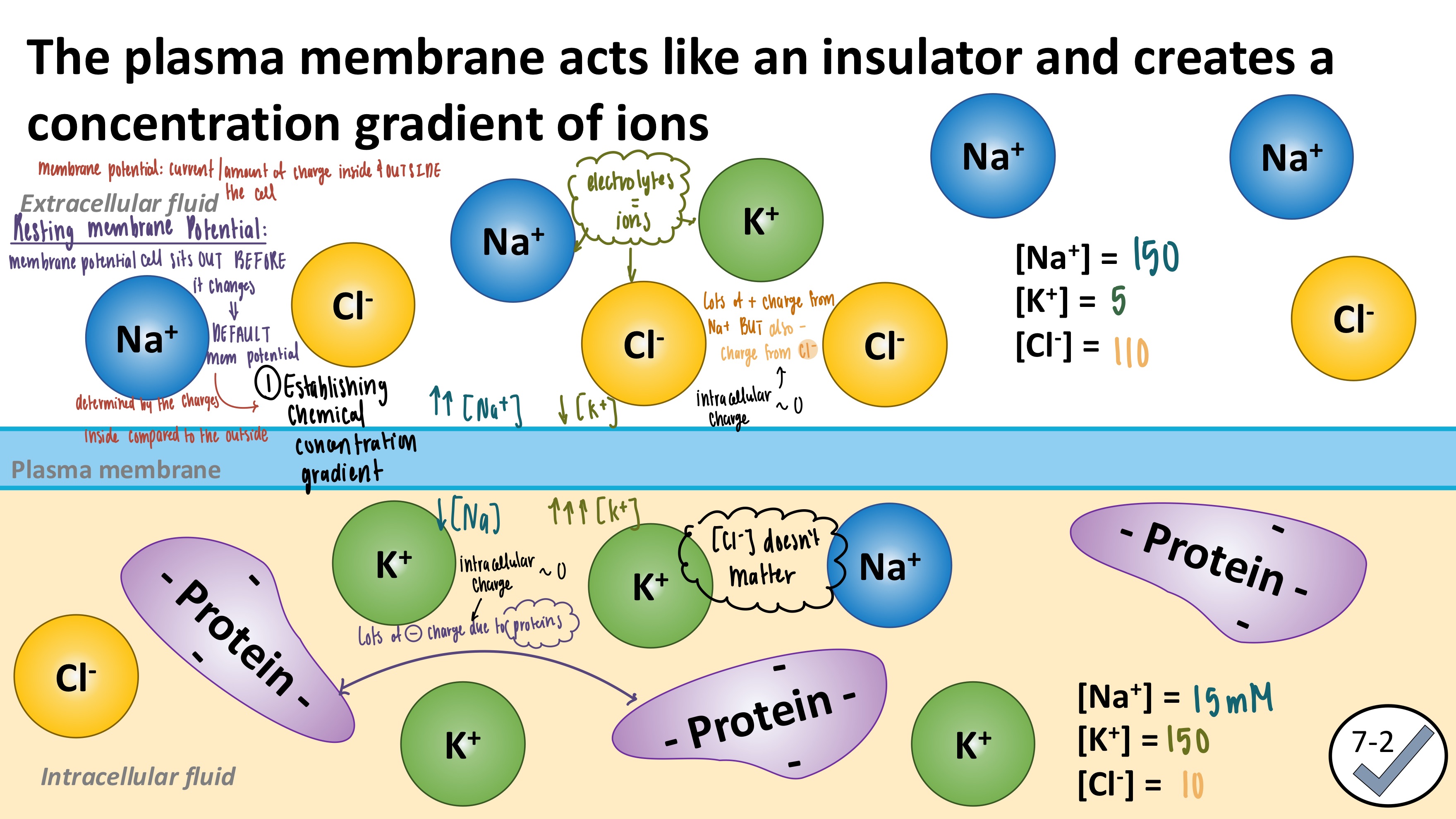
In a sentence or two, describe what the resting membrane potential of a cell is.
What is the resting membrane potential of neurons (give units)?
Resting Membrane Potential
Membrane potential BEFORE it changes (NOT conducting electricity, NOT excited)
-70mV
Has the ability to trigger a response, but the neuron must be excited first
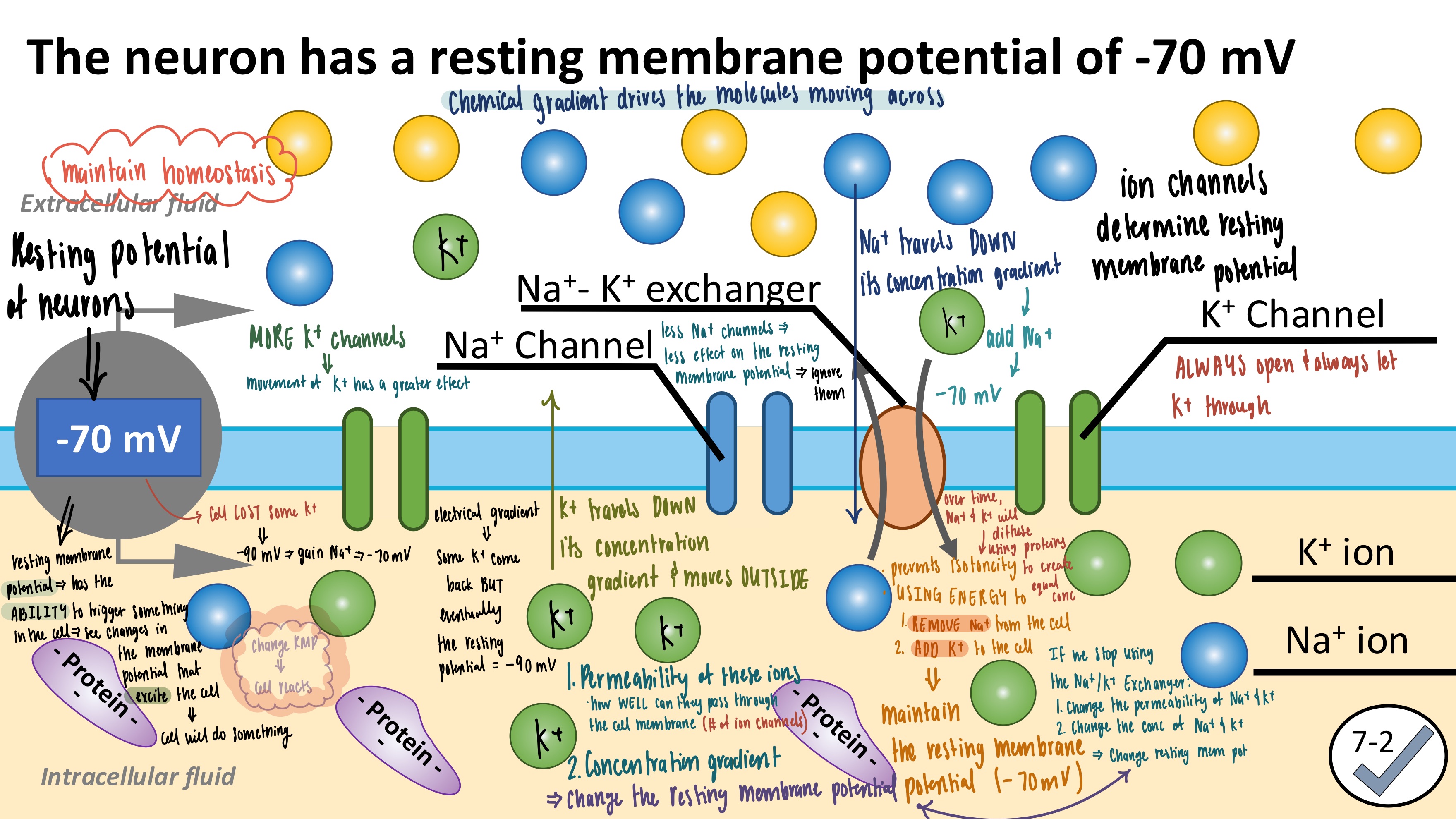
What two factors generate the resting membrane potential?
Concentration/Chemical Gradient
ions moving down their concentration gradients starts off the electrochemical gradient
Permeability (ion channels)
How WELL can ions pass through the cell membranes
Na+ Leaky Channel
K+ Leaky Channel
Na+/K+ Exchanger
How does the cell maintain the chemical gradient of Na+ and K+?
Na+/K+ Exchanger:
Using ENERGY to:
REMOVE Na+ from the cell
ADD K+ to the cell
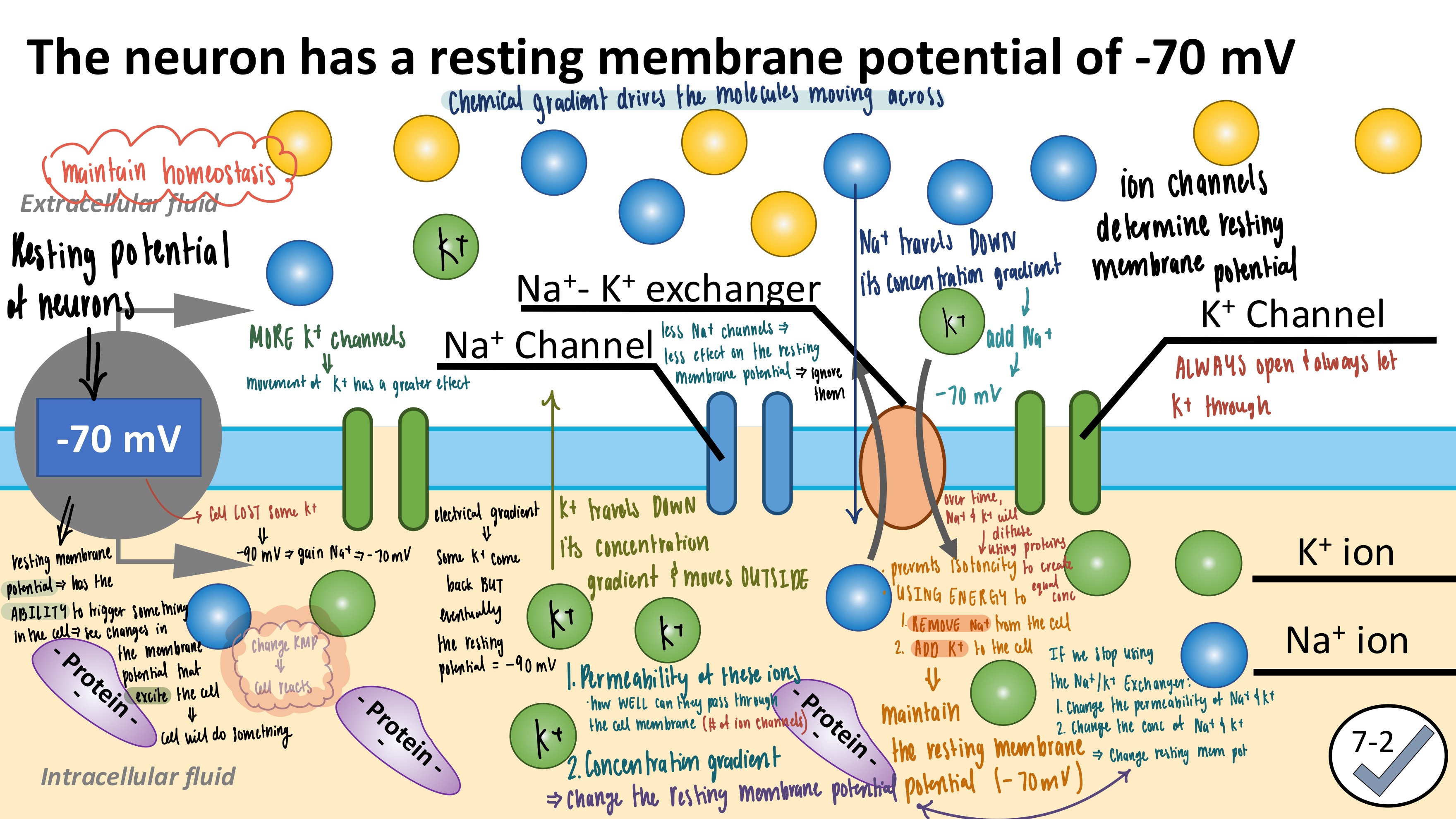
Scenarios that change the overall resting membrane potential (discussion slides)
add pic
Changing the Ion Concentration
ADD Na+to the ECF:
Overall increase the extracellular [Na+] → FASTER diffusion → increase the resting membrane potential
ADD Na + leakage channels
Increase the permeability of Na+ → increase the opportunity for Na+ to diffuse into the cell → increase the resting membrane potential
What does it mean for a membrane to depolarize or to hyperpolarize?
Describe events that can hyperpolarize or depolarize a neuron?
NOTE: How can you change ion concentration or permeability to hyperpolarize or depolarize a neuron?
add pic
Depolarization: membrane potential is CLOSER to 0 (more positive)
Increase Na+ Permeabilty: OPEN Na+ chemically-gated channels
Decrease K+ Permeability: REMOVE K+ leaky channels
Hyperpolarization: membrane potential is FURTHER AWAY from 0 (more negative)
OPEN K+ chemically-gated channels
Describe how a chemically gated ion channel works.
Stimulus: ligand (neurotransmitter- a chemical signal)
ligand/neurotransmitter BINDS to the active site of the chemically gated ion channel
Chemically gated ion channel OPENS
Ions can flow into the cell
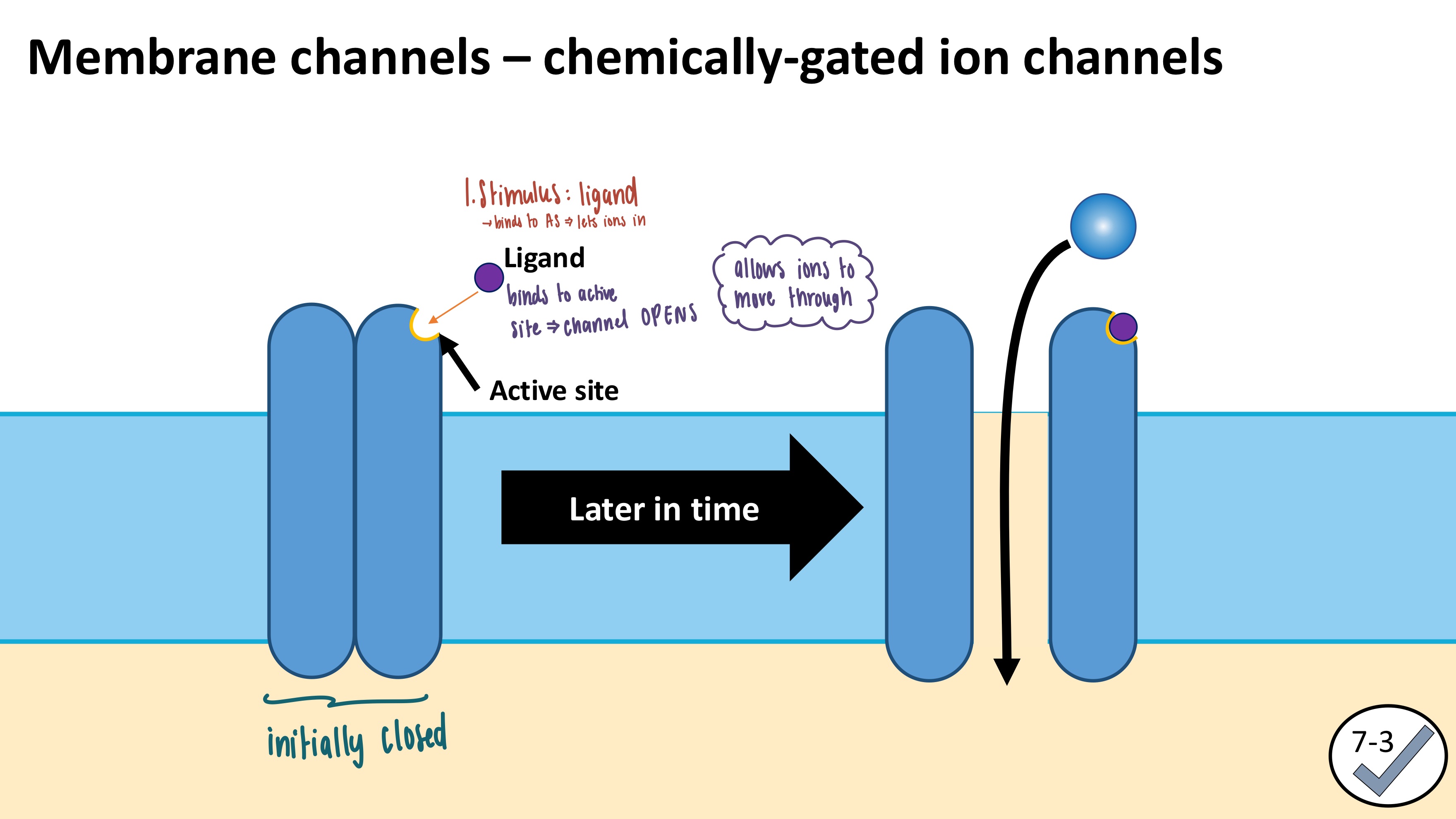
What can be a stimulus to a graded potential?
Neurotransmitters (chemical signals)
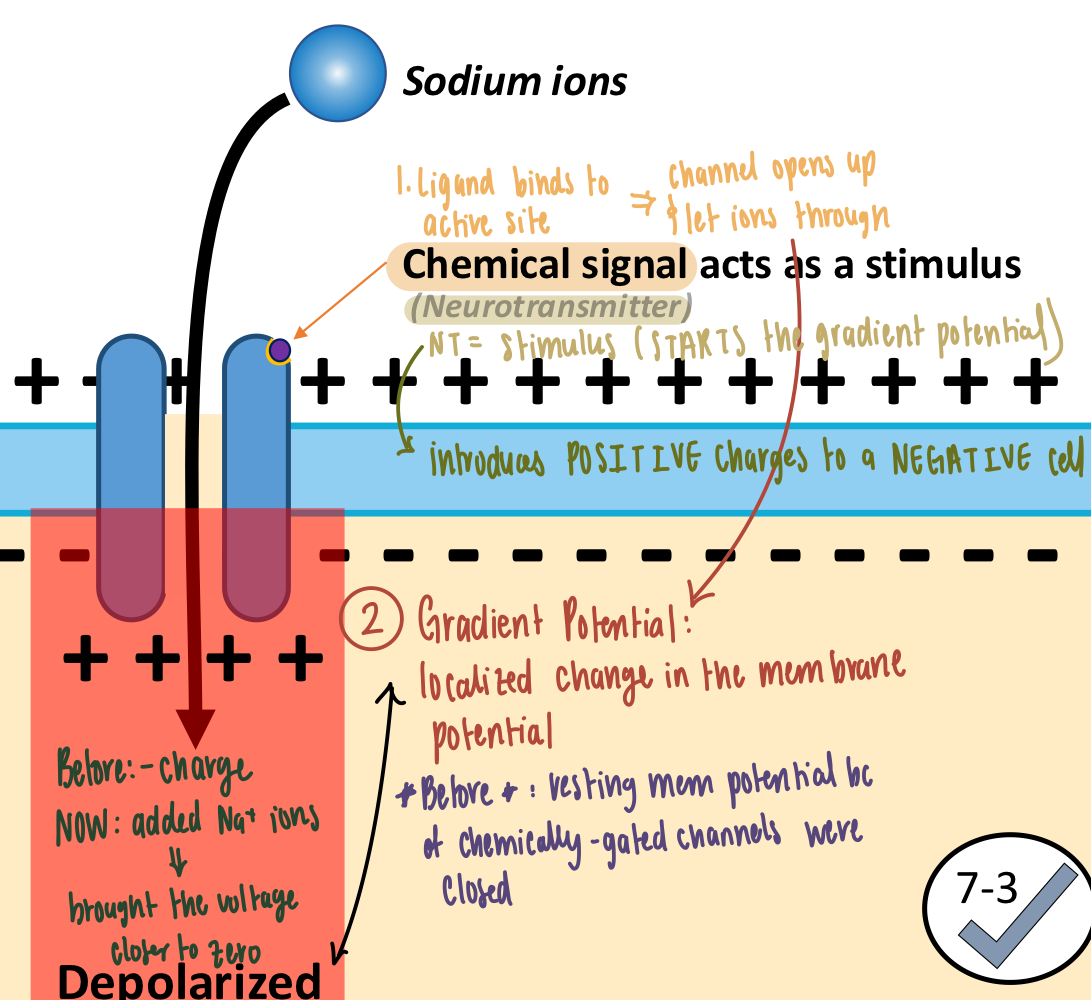
Briefly describe what electrical current is.
Is current faster or slower than chemical diffusion?
Electrical Current: Flow of electrical charge from one point to another point
FASTER than chemical diffusion
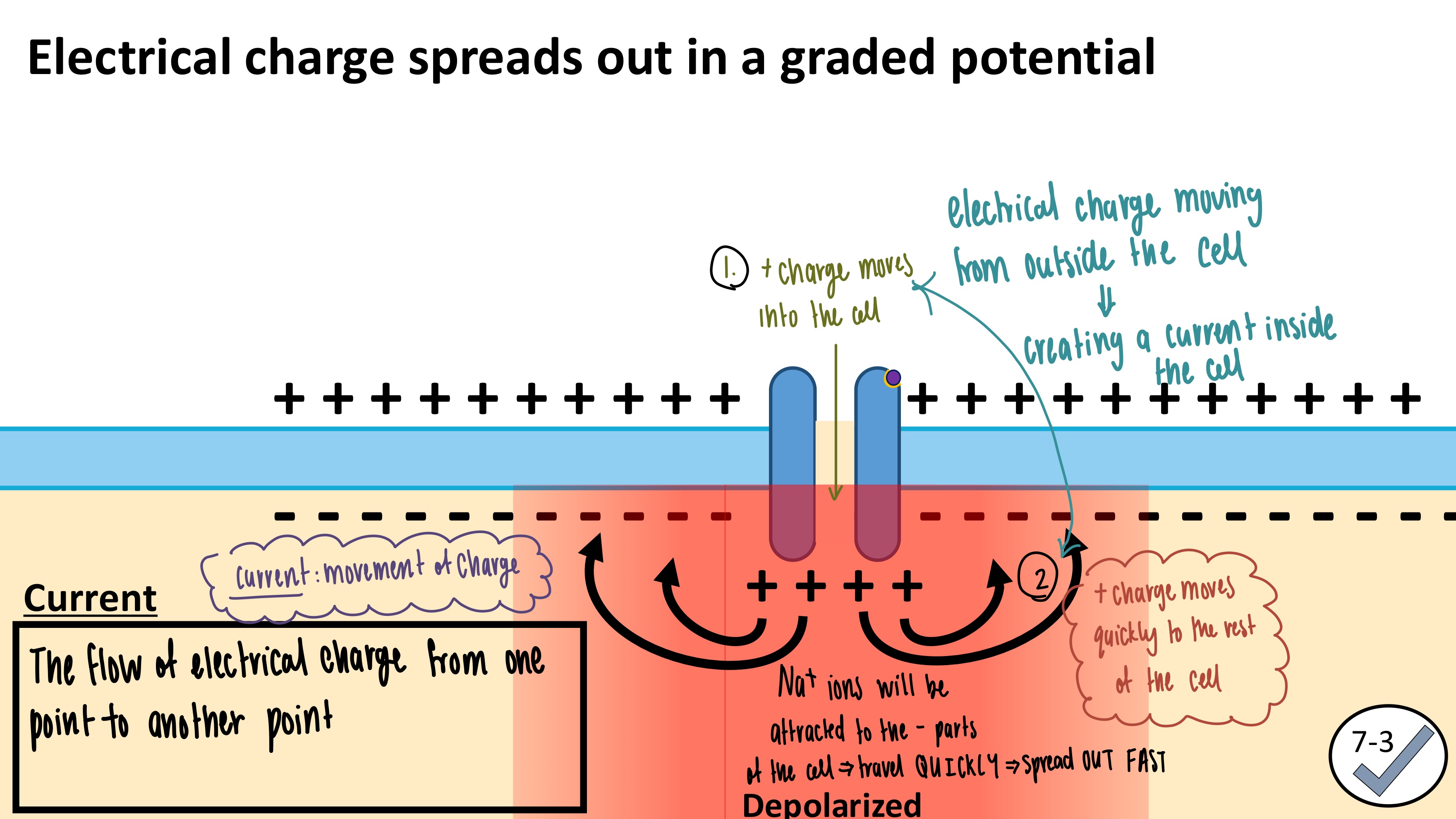
How can a graded potential hyperpolarize or depolarize a cell?
Depolarization (closer to 0, more positive)
OPEN Na+ chemically gated channel to let Na+ in
Positive charge spreads out throughout the cell (attracted to negatively charged proteins)
Hyperpolarization (moves AWAY from 0, more negative)
Open Cl- chemically gated channels
Negative charge spread throughout the cell → membrane potential becomes more negative
Opening K+ Channels
K+ ions move OUT of the cell
Close Na+ chemically gated channels
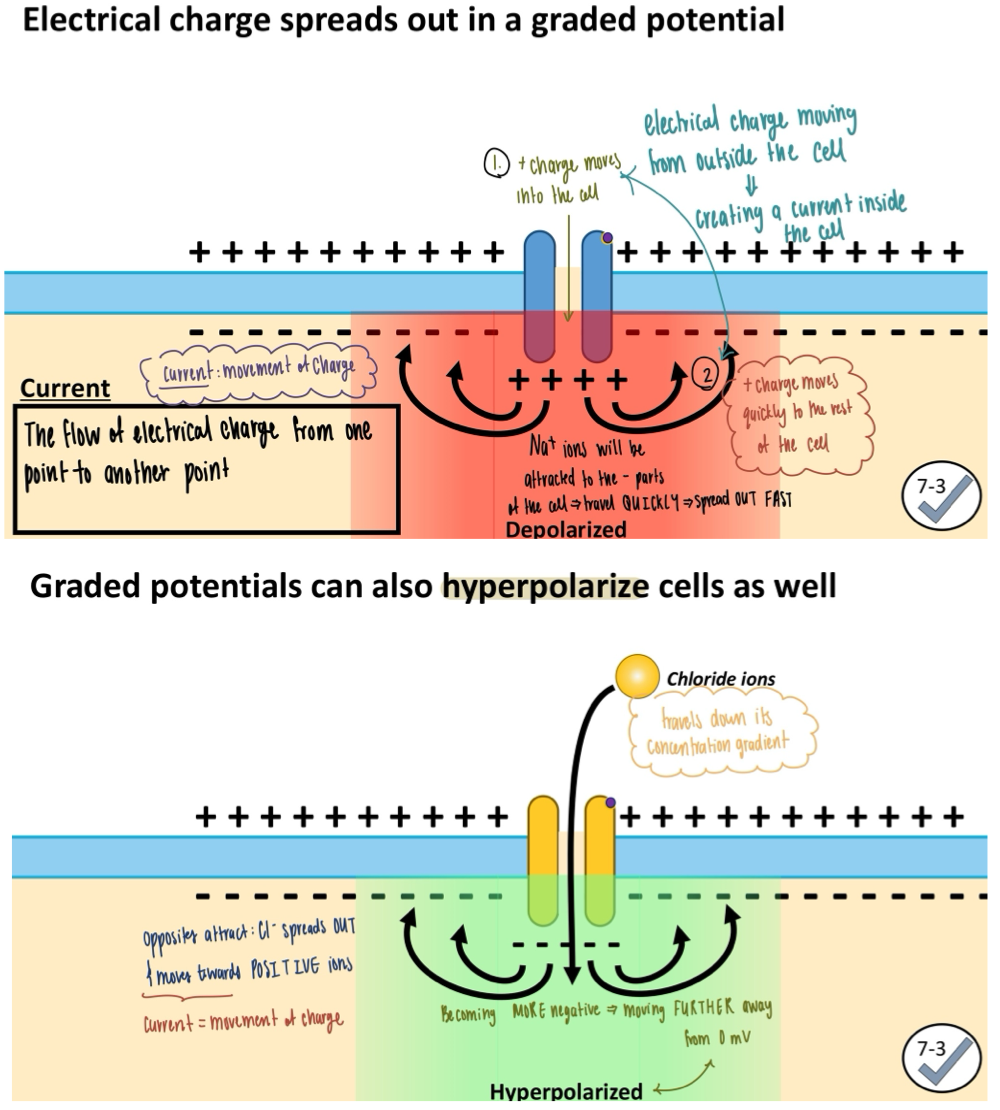
How can a graded potential vary the amount of depolarization or hyperpolarization that occurs in the neuron?
verify w/ nair
Graded Potential Strength varies by:
Time
↑ time: ↓ strength
Distance
↑ distance: ↓ strength
Ion Permeability
↑ Na+ permeability (↑ # of channels): ↑ strength
Concentration
↑ [Na+] = ↑ strength
Where in the neuron does a graded potential occur?
Dendrites & axon
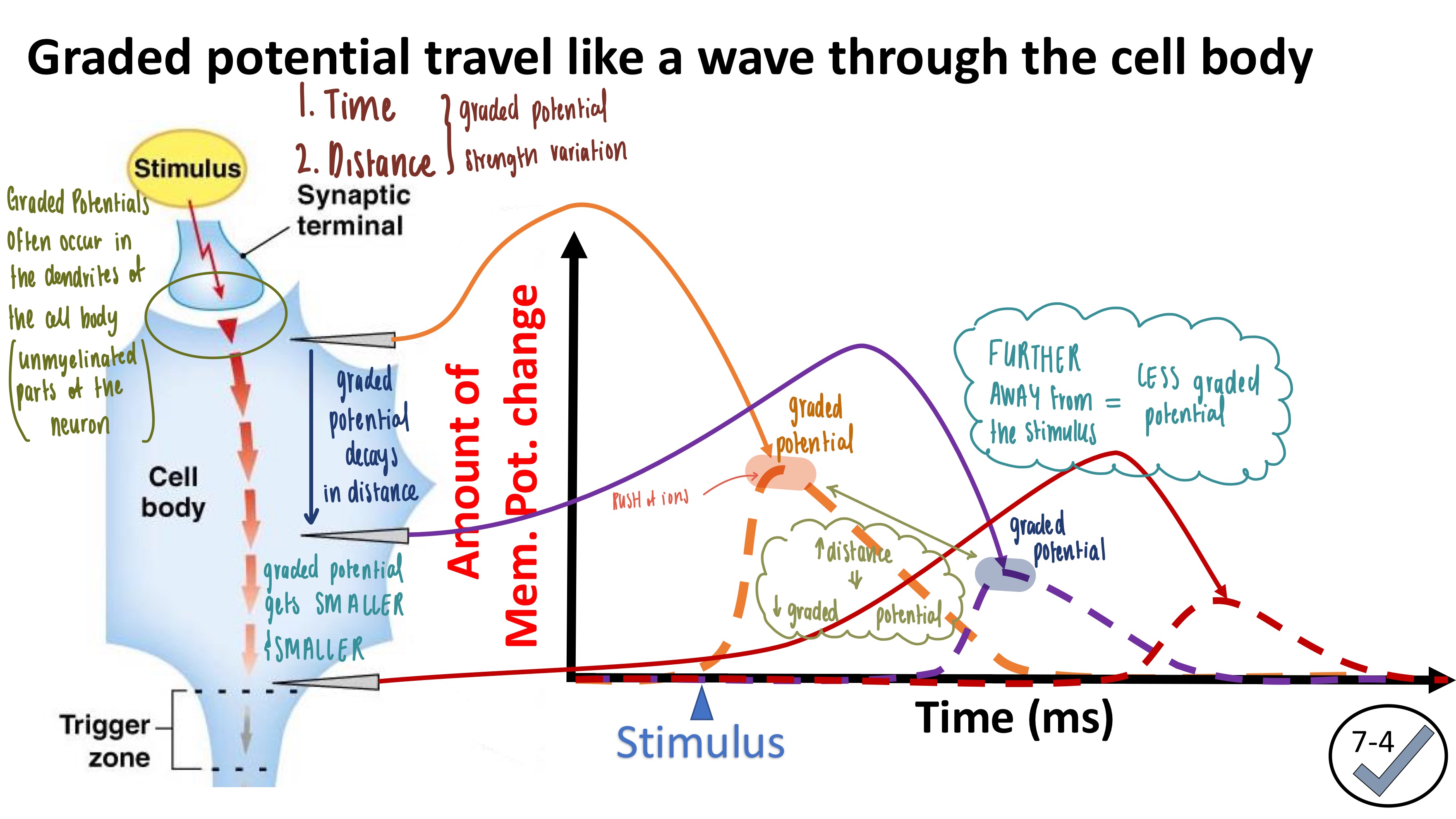
What is the “strength” of a graded potential?
Can the “strength” of a graded potential vary?
What can cause that variation?
Strength: depolarization ability
Trying to reach the -50 mV or above threshold
Strength Variation
Time
↑ time: ↓ strength
Distance
↑ distance: ↓ strength
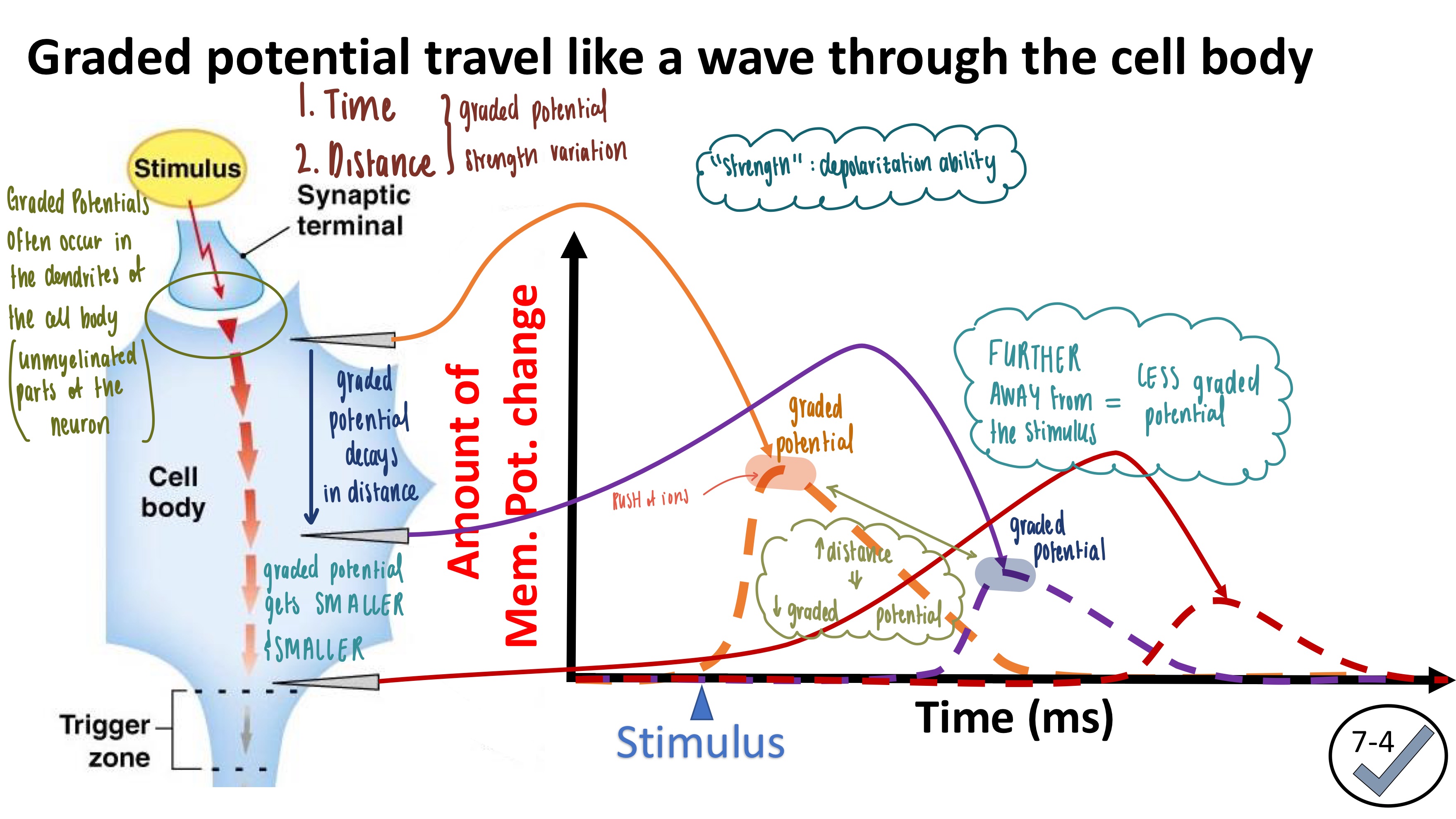
For a given portion of a neuron’s cell membrane, describe how the membrane potential varies over time given a hyperpolarizing or depolarizing graded potential.
Describe the movement of ions across the membrane patch for either situation.
Depolarization
Stimulus (neurotransmitter) triggers Na+ chemically-gated channel to open
Rush of Na+ ions INTO the cell depolarizes the cell
Hyperpolarization
K+ chemically gated channel opens after Na+ chemically-gated channels
K+ ions LEAVE the cell
Na+ions move AWAY from the chemically-gated channels
Na+ ions leave via leaky Na+ channels
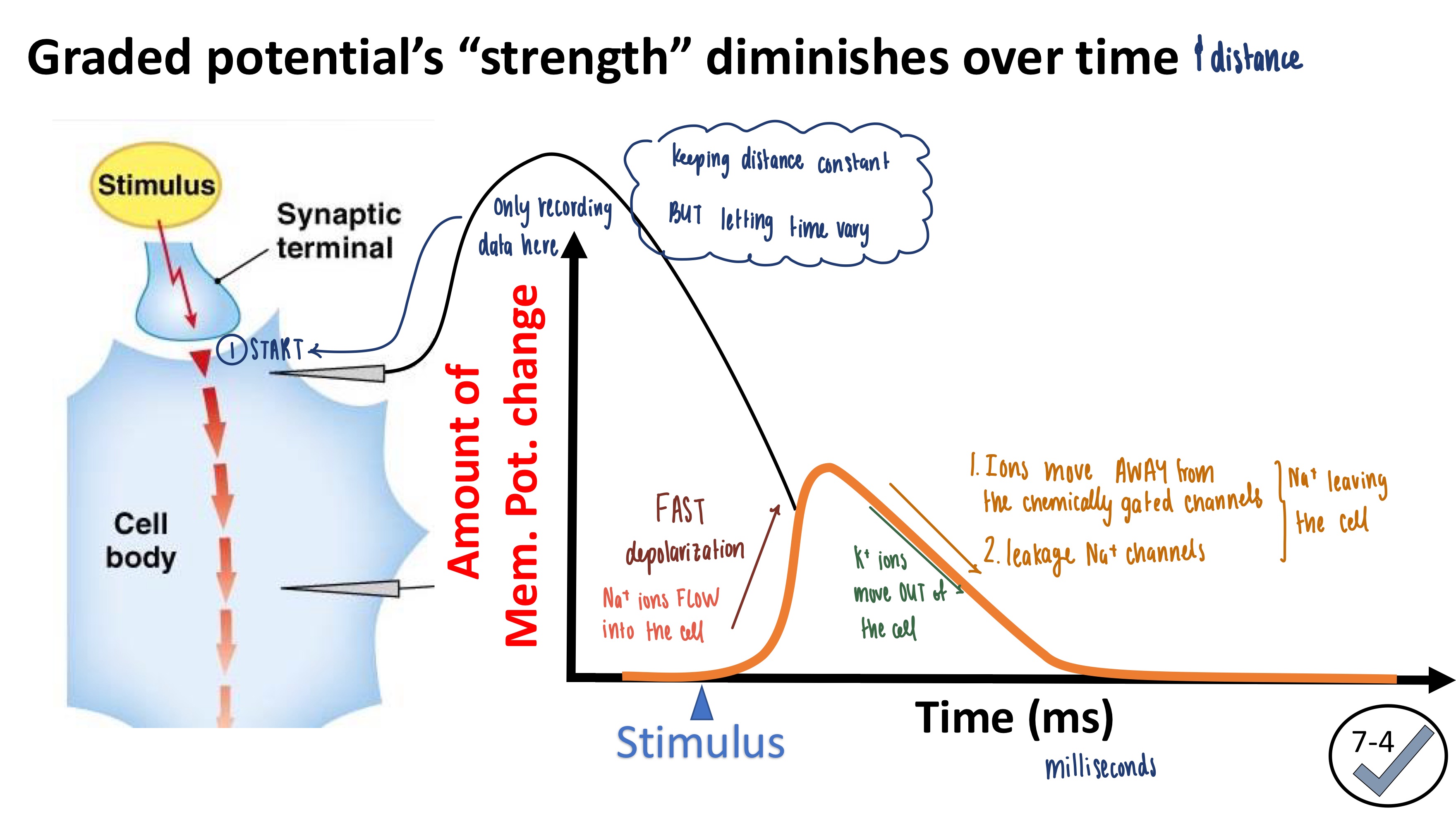
In a small paragraph, describe how the membrane potential varies over time AND distance as a graded potential moves across the cell body.
Describe the movement of ions within the cell body as the graded potential moves away from the stimulus.
Membrane Potential
Peaks QUICKLY but decreases over time
Decays as time and distance increase
Travels as a “wave” through the cell body
Movement of ions
RUSH of Na+ ions depolarize the cell QUICKLY, but as Na+ & K+ leave the cell, it hyperpolarizes
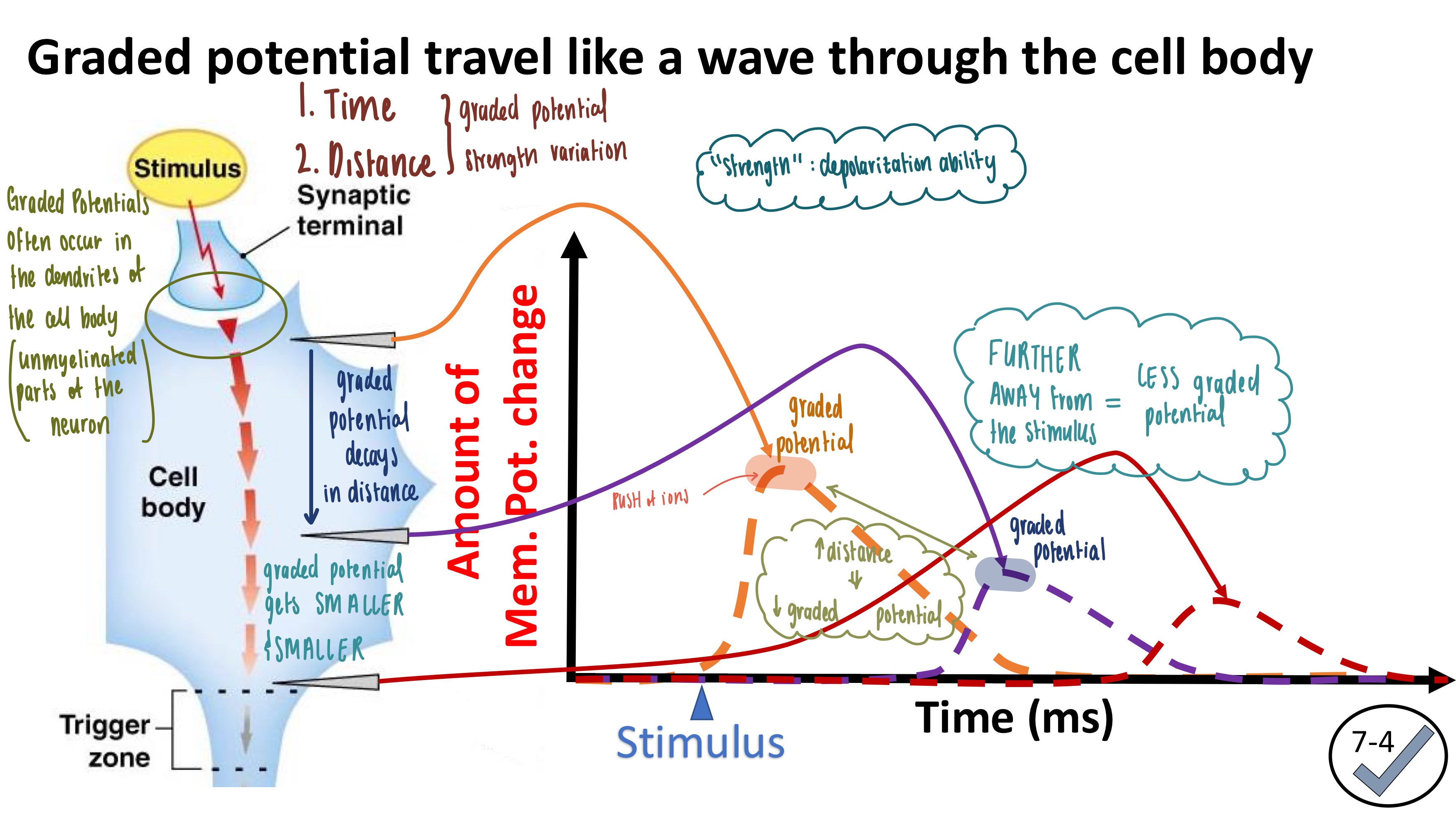
Describe how a voltage-gated ion channel works.
Requires at least -55 mV to open
Depolarizes the membrane potential
Increases the permeability of ions (lets them into/out the cell)
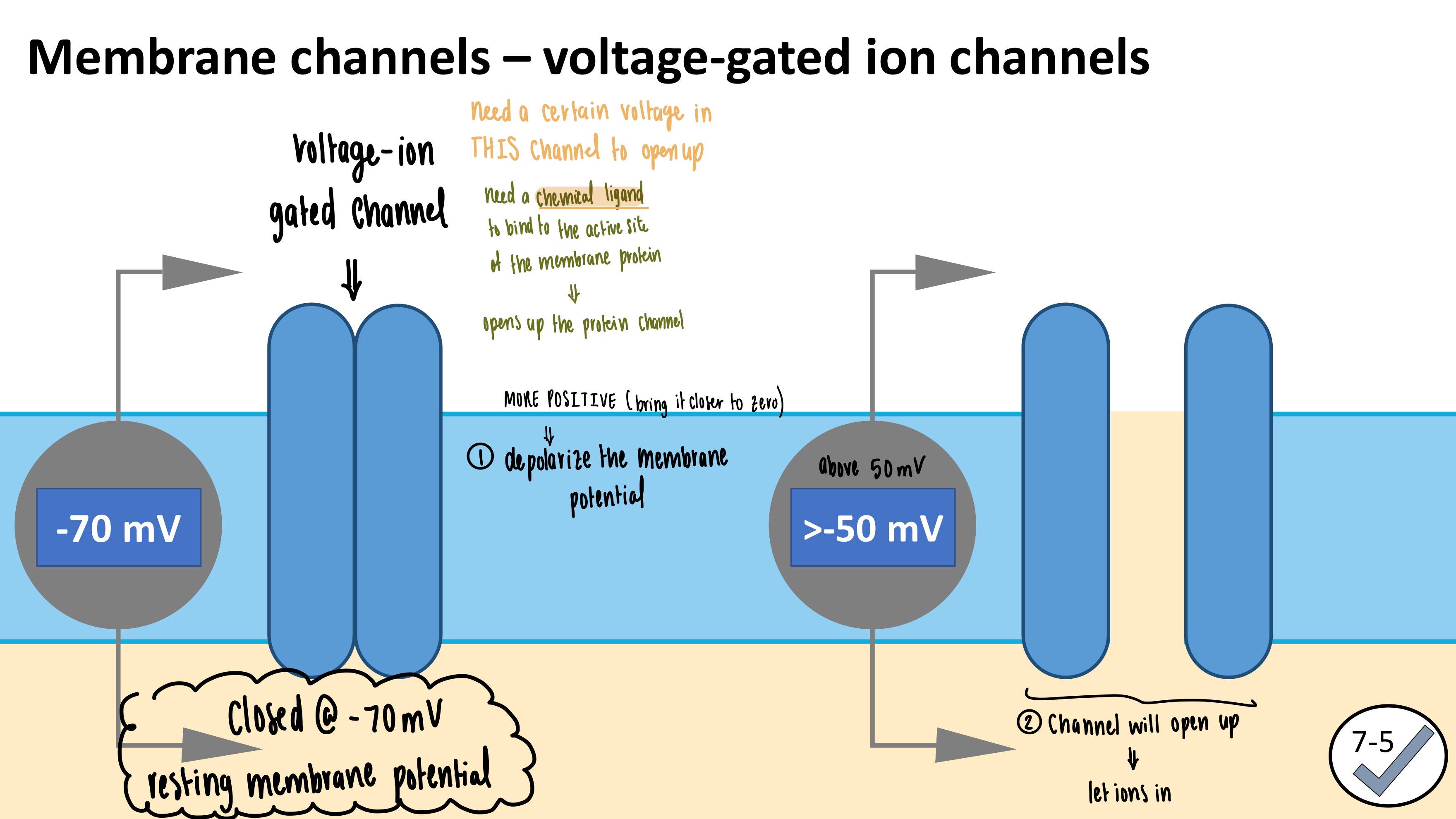
Where do action potentials occur in a neuron?
Axon
4 Phases of the action potential
Resting: -70 mV
Depolarization: more than -50 mV
Repolarization: -70mV
Hyperpolarization: -90 mV, then -70mV
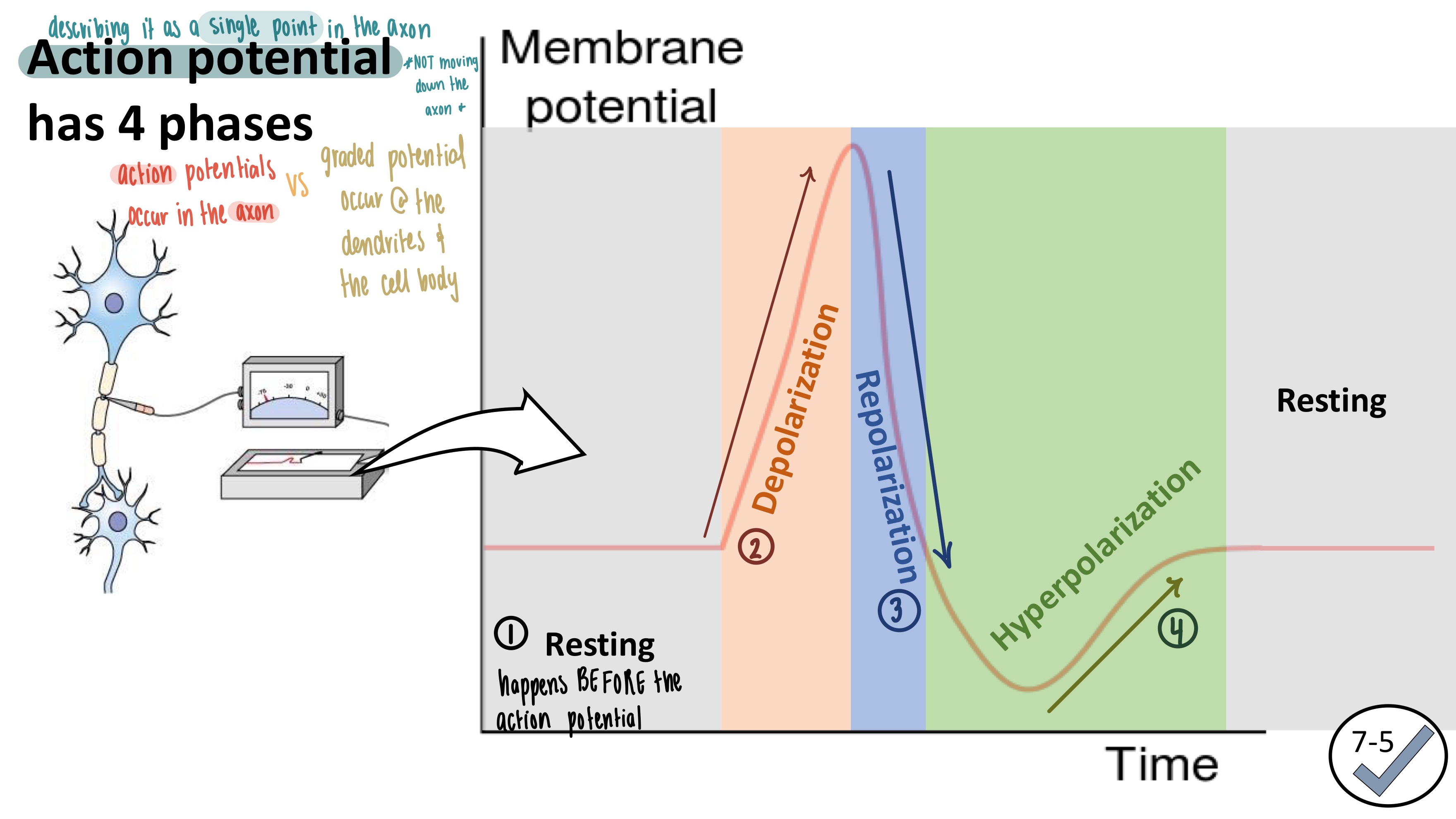
Action Potential Resting Phase
Occurs BEFORE the action potential
MINIMAL permeability
Na+ and K+ voltage-gated channels are CLOSED
leaky ion channels allow very little ion diffusion
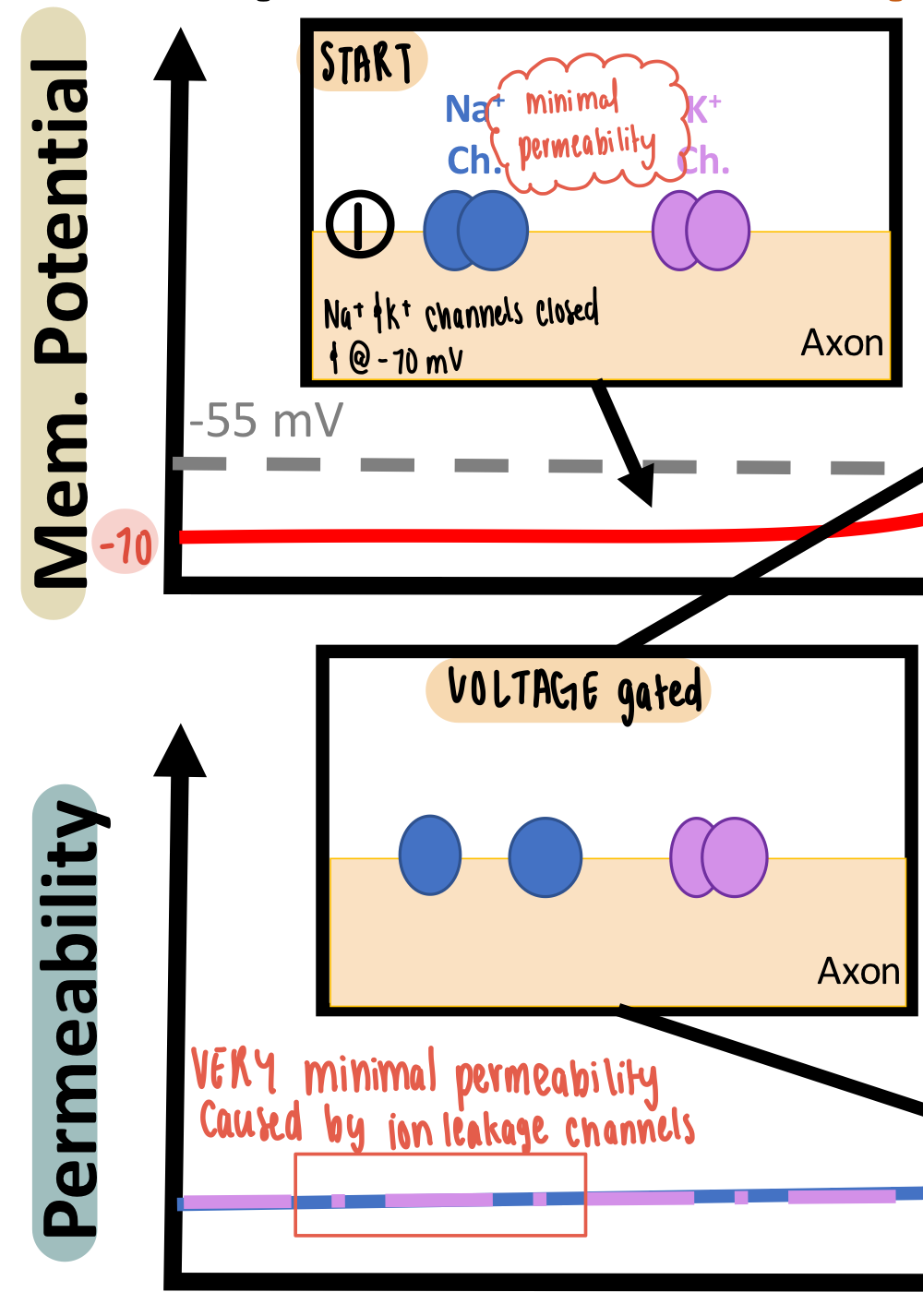
Action Potential Depolarization Phase
Membrane Potential increases to -55mV
Na+ voltage gate opens & allows Na+ INTO the cell
permeability INCREASES the membrane potential
Na+ positive charge brings the membrane potential closer to 0
K+ voltage-gated channels open up after Na+
Membrane potential plateaus/flattens
K+ voltage-gated channels are still open & K+ ions are escaping the cell
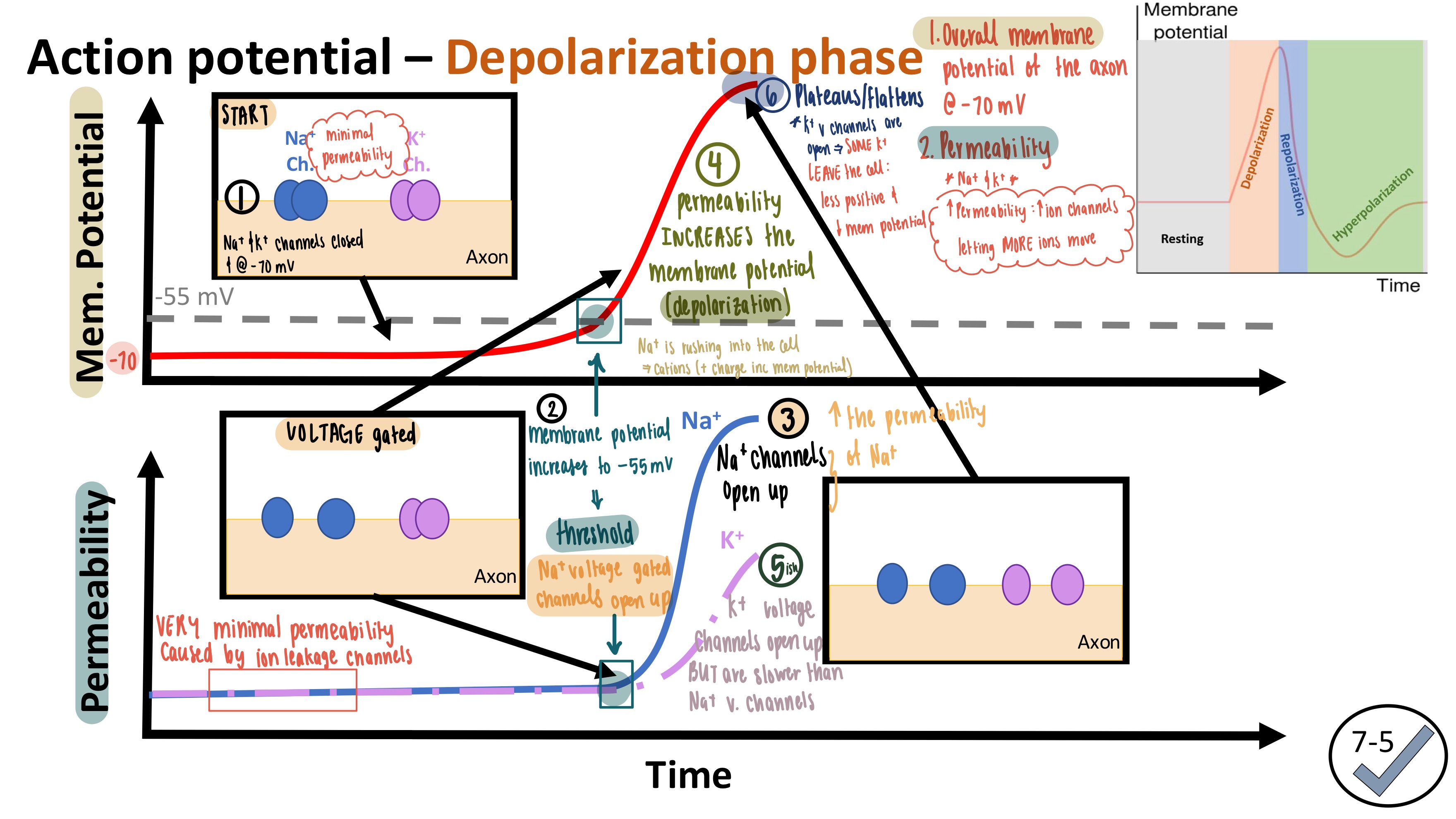
Action Potential Repolarization Phase
Membrane Potential starts to decrease
Na+ voltage-gated channels CLOSE UP
DECREASE Na+ permeability QUICKLY
K+ voltage gate channels are still open
always delayed
K+ ions are still escaping & decreasing the membrane potential
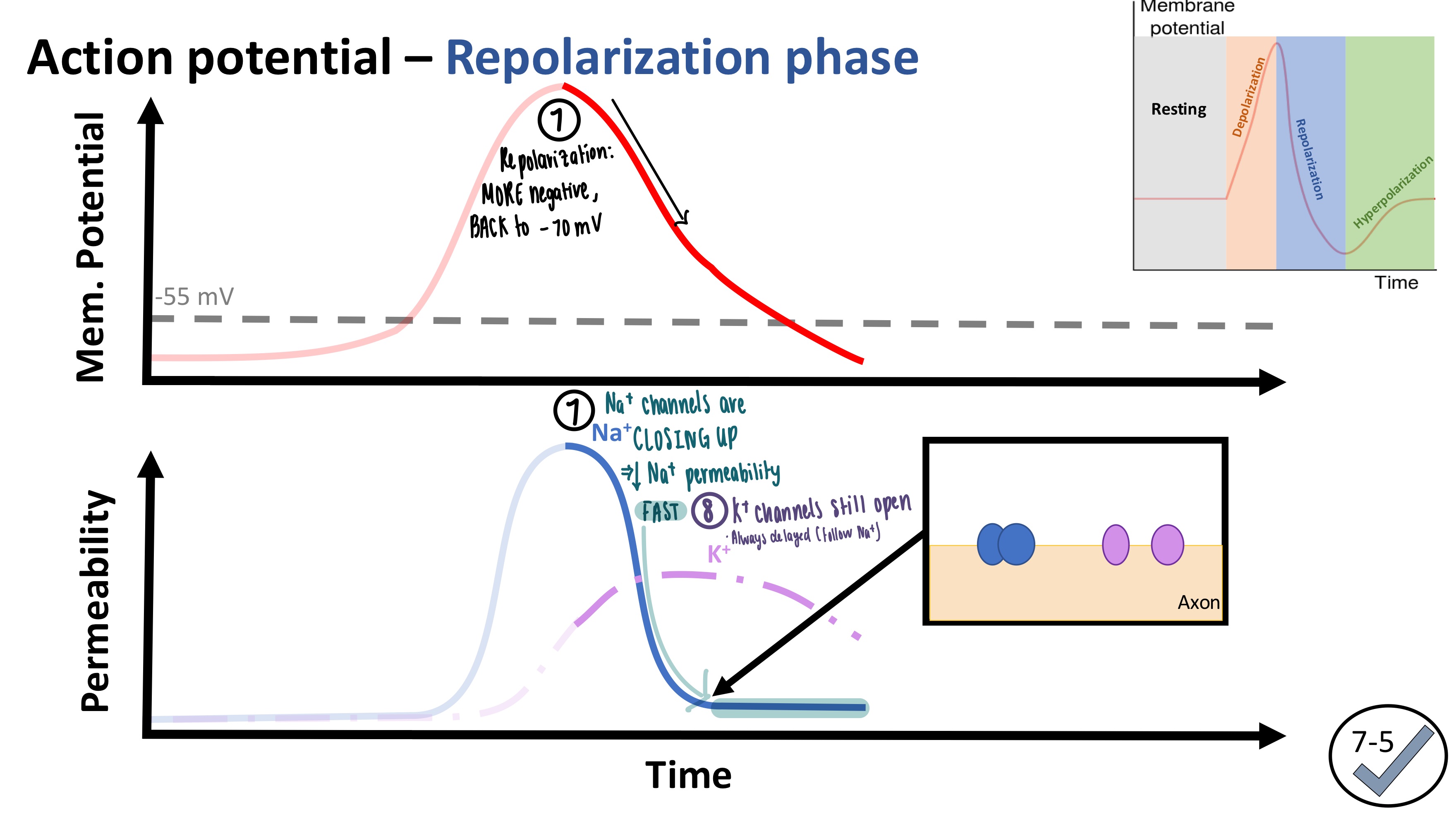
Action Potential Hyperpolarization Phase
Membrane Potential is LESS than -70 mV (usually -90 mV)
Na+ voltage-gated channels are closed
SOME K+ voltage-gated channels are open
K+ ions are LEAVING the cell
K+ channels CLOSE
Na+/K+ ATPase Exchanger brings the membrane potential BACK to -70 mV
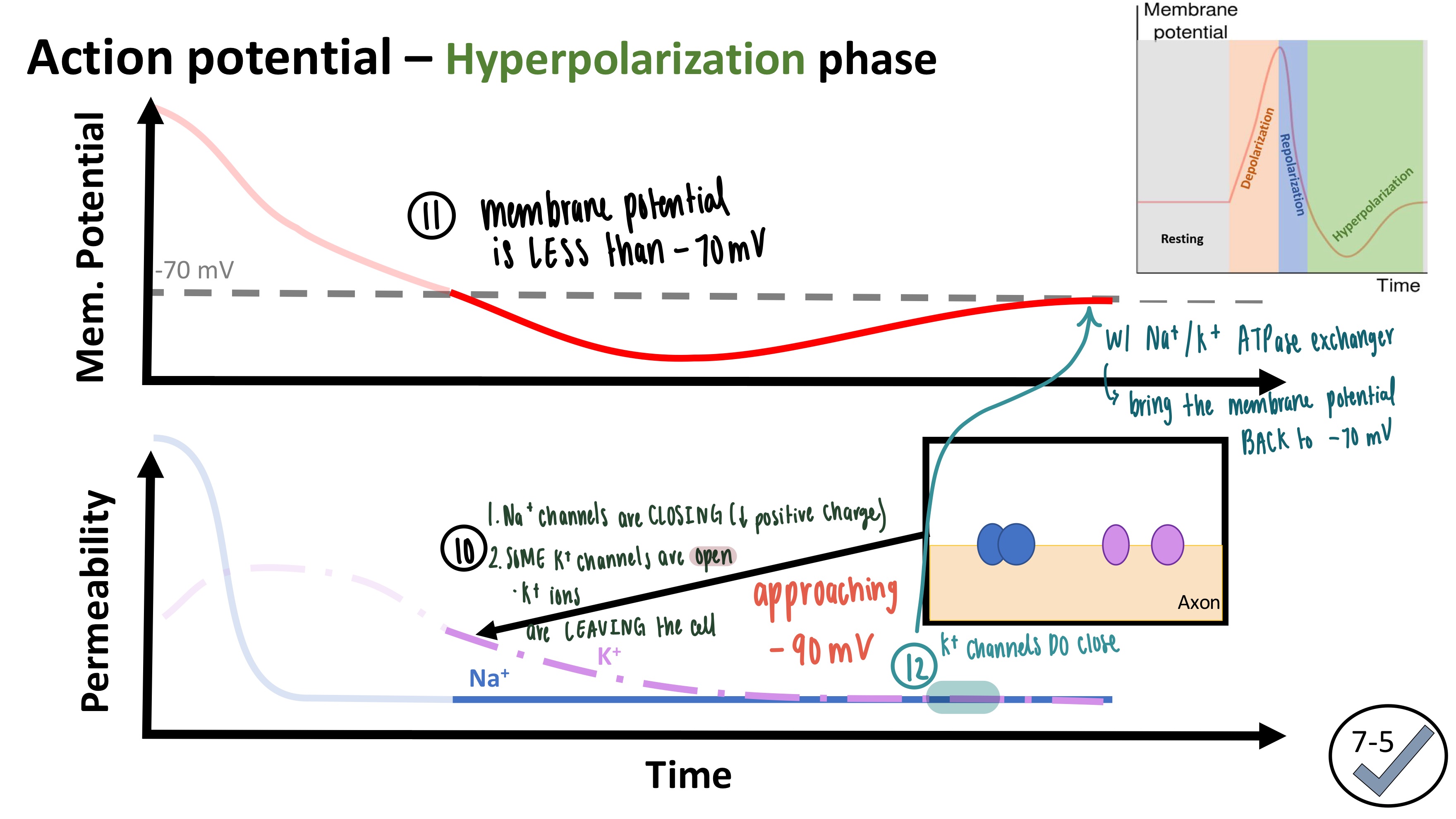
What causes the pattern of permeability in an action potential?
verify w/ nair
Ion voltage-gated channels opening & closing
Concentration gradient??
At the beginning of the axon, how does the first action potential get triggered?
Suprathreshold (at least -55 mV) graded potentials at the axon hillock trigger the first action potential
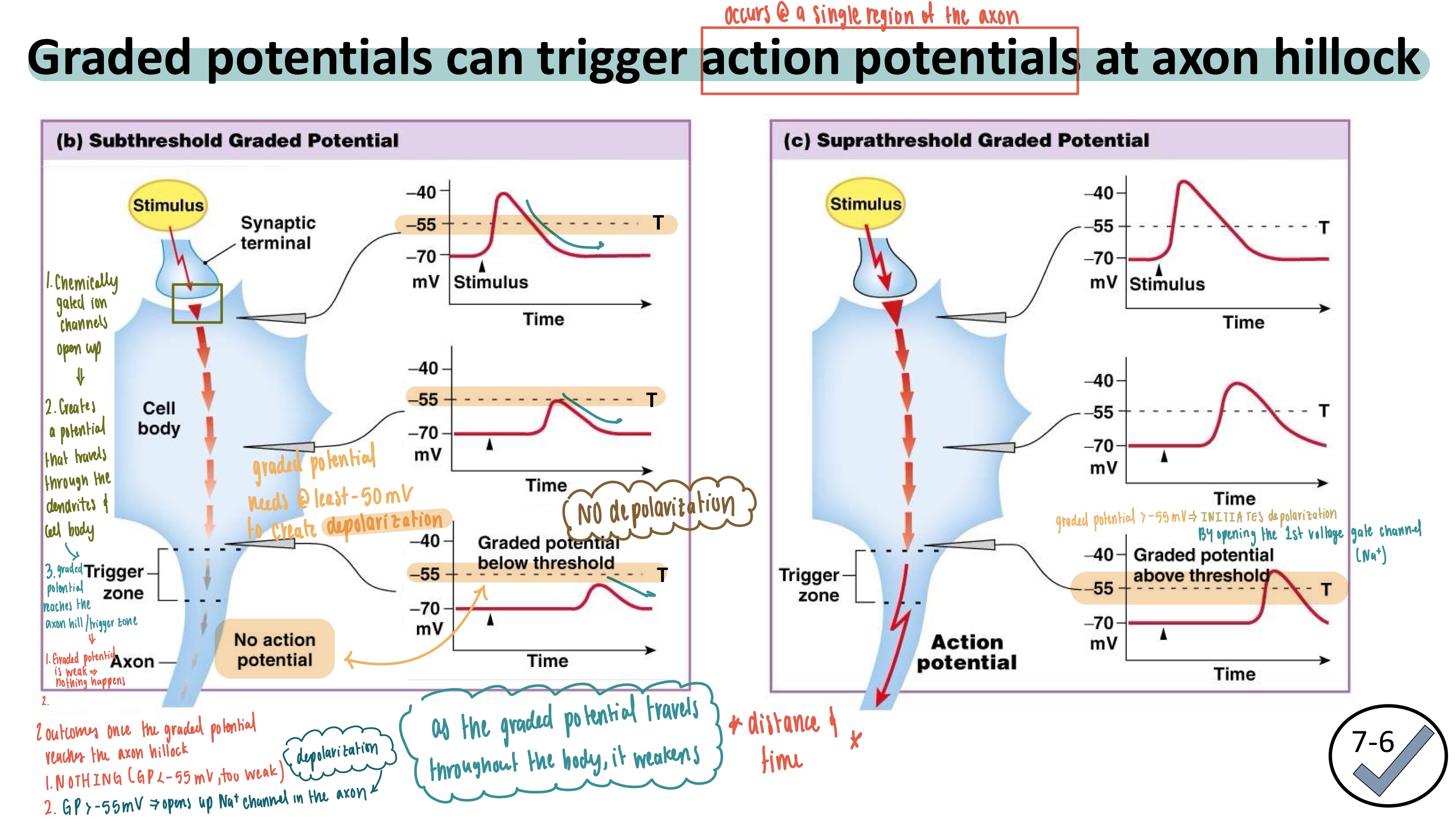
What does it mean for a graded potential to be a subthreshold stimulus?
What is the voltage needed to start an action potential at the axon hillock typically?
Subthreshold stimulus: less than -55 mV
at LEAST-55mV to trigger an action potential
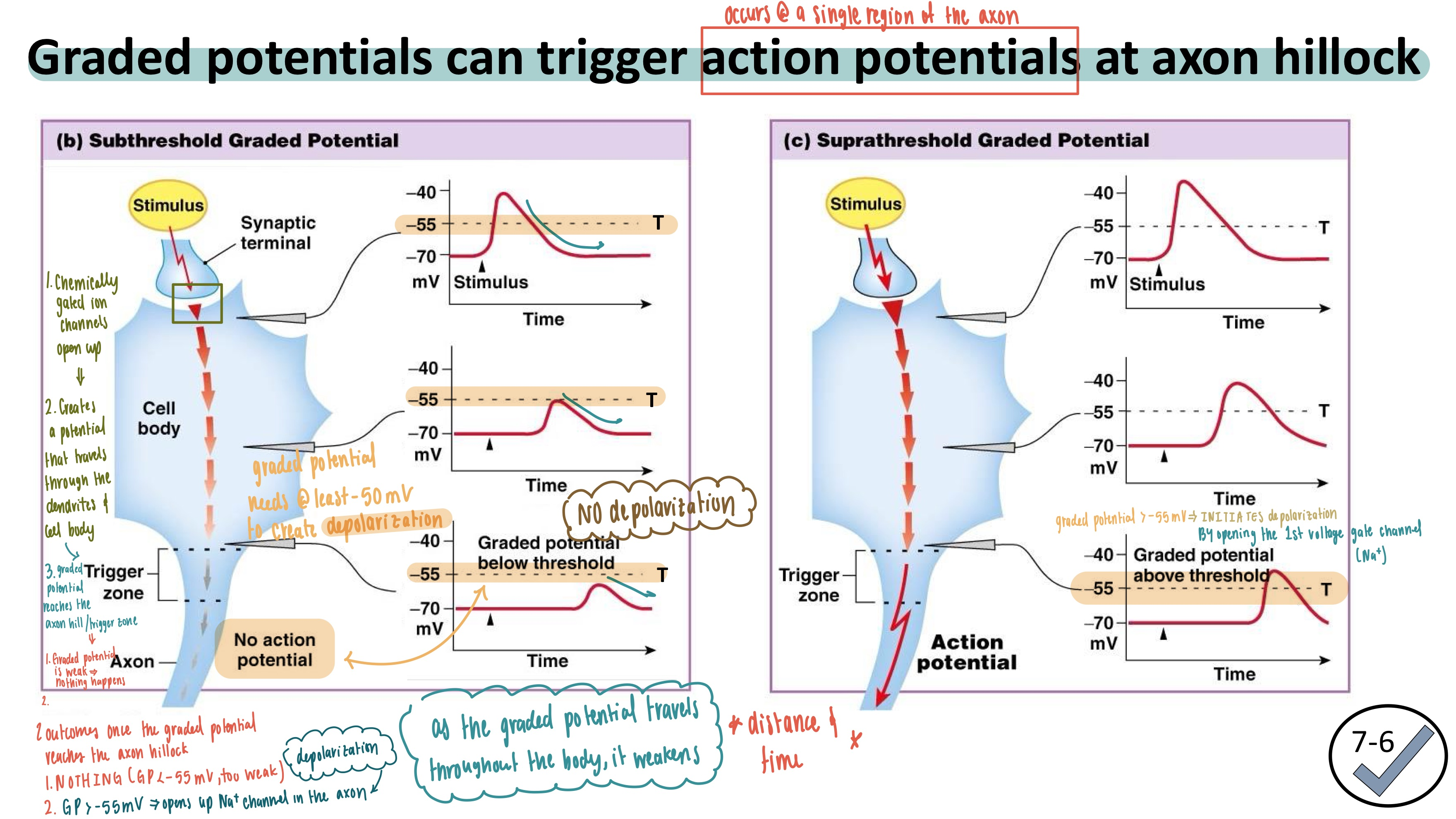
What does it mean for an action potential to be an “all-or-none” phenomenon?
Action potentials either happen OR NOT
have the EXACT amount of depolarization & repolarization
All action potentials (in a series) look the same
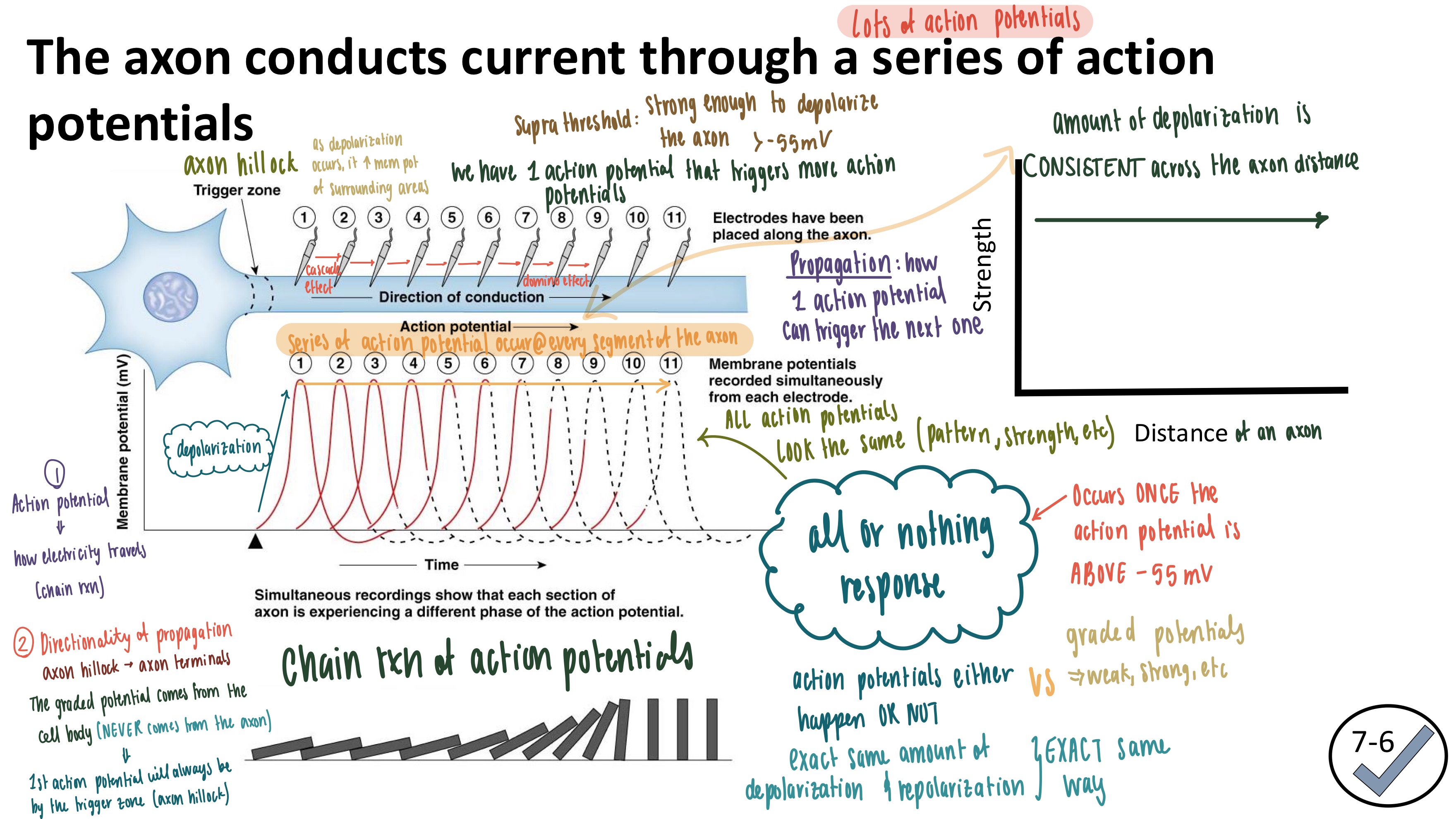
In what direction along the axon do action potentials propagate?
Propagate across the axon (left → right)
from the axon hillock/trigger zone TO the axon terminal
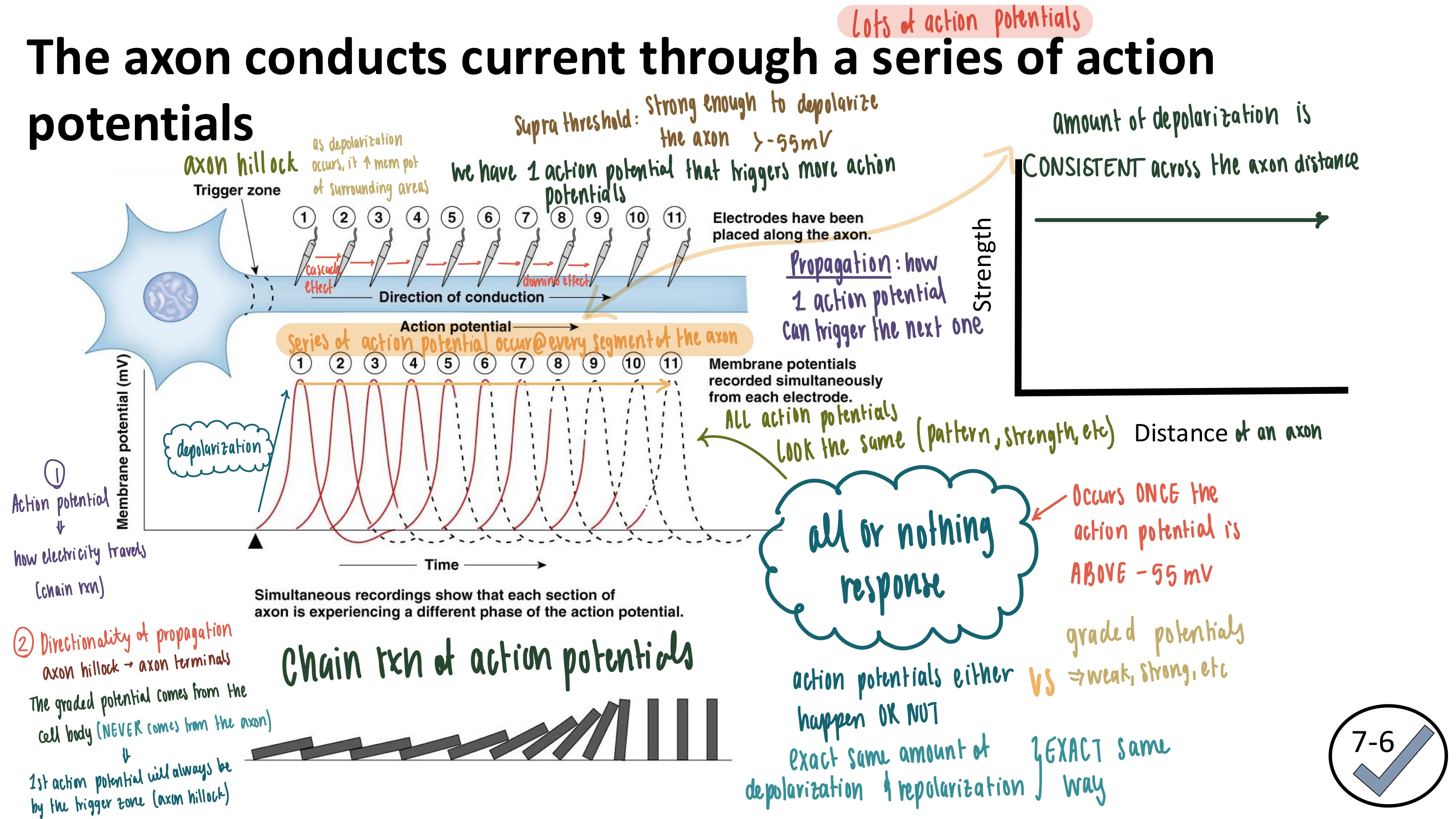
What is a neurotransmitter, and where is it released from?
What triggers the release of neurotransmitters?
Neurotransmitter: chemical released by axon terminals of neurons
Action potentials trigger a release of neurotransmitters at the axon terminal
Action potential depolarizes the axon terminal
Ca2+ ENTRY (into the presynaptic neuron) tiggers exocytosis of neurotransmitters
Neurotransmitter diffuses across the synaptic cleft & binds with receptors on the postsynaptic cell
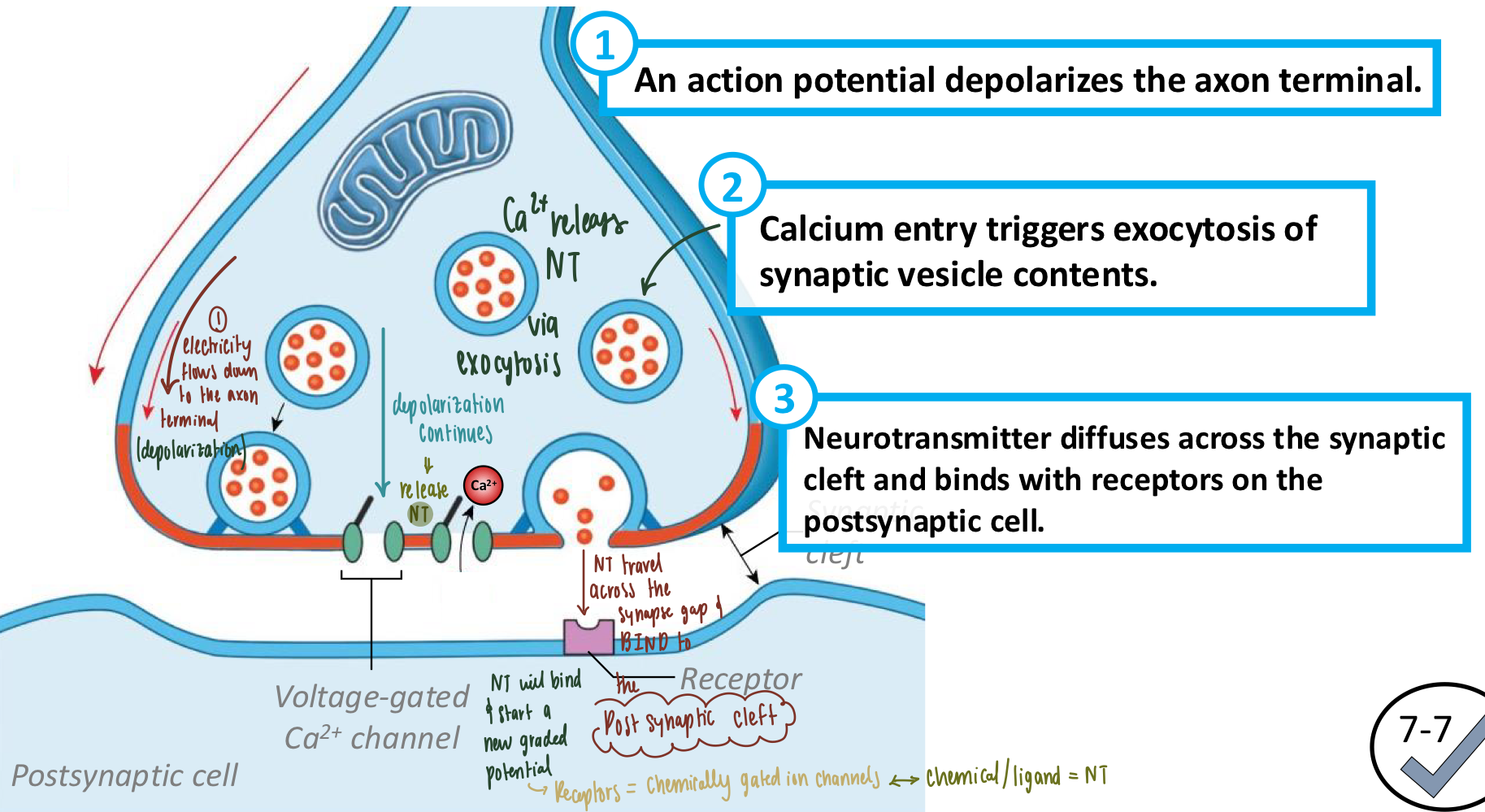
How does a neuron code for stimulus strength in action potentials? Note: Action potentials are “all-or-none.” Note: There is no such thing as “small or large” action potentials.
Stimulus Strength: frequency of action potentials
Weak stimulus: LOW frequency of action potentials
Strong stimulus: HIGH frequency of action potentials
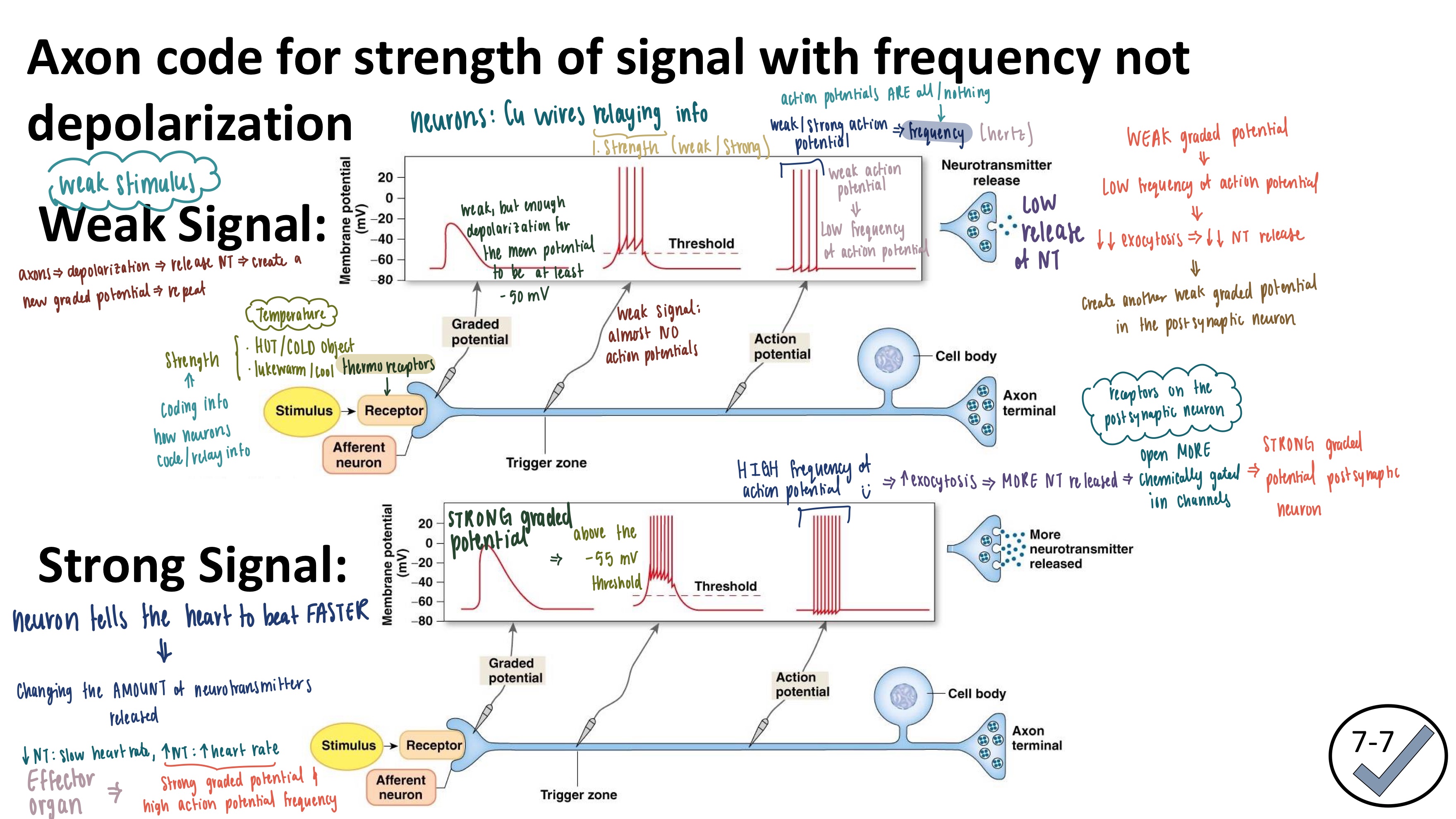
How does a presynaptic neuron express signal strength to a postsynaptic neuron? Note: Consider what is happening at the synapse between the two neurons.
Signal Strength: amount of neurotransmitters released
Weak signal: LOW release of neurotransmitters
Strong signal: HIGH release of neurotransmitters
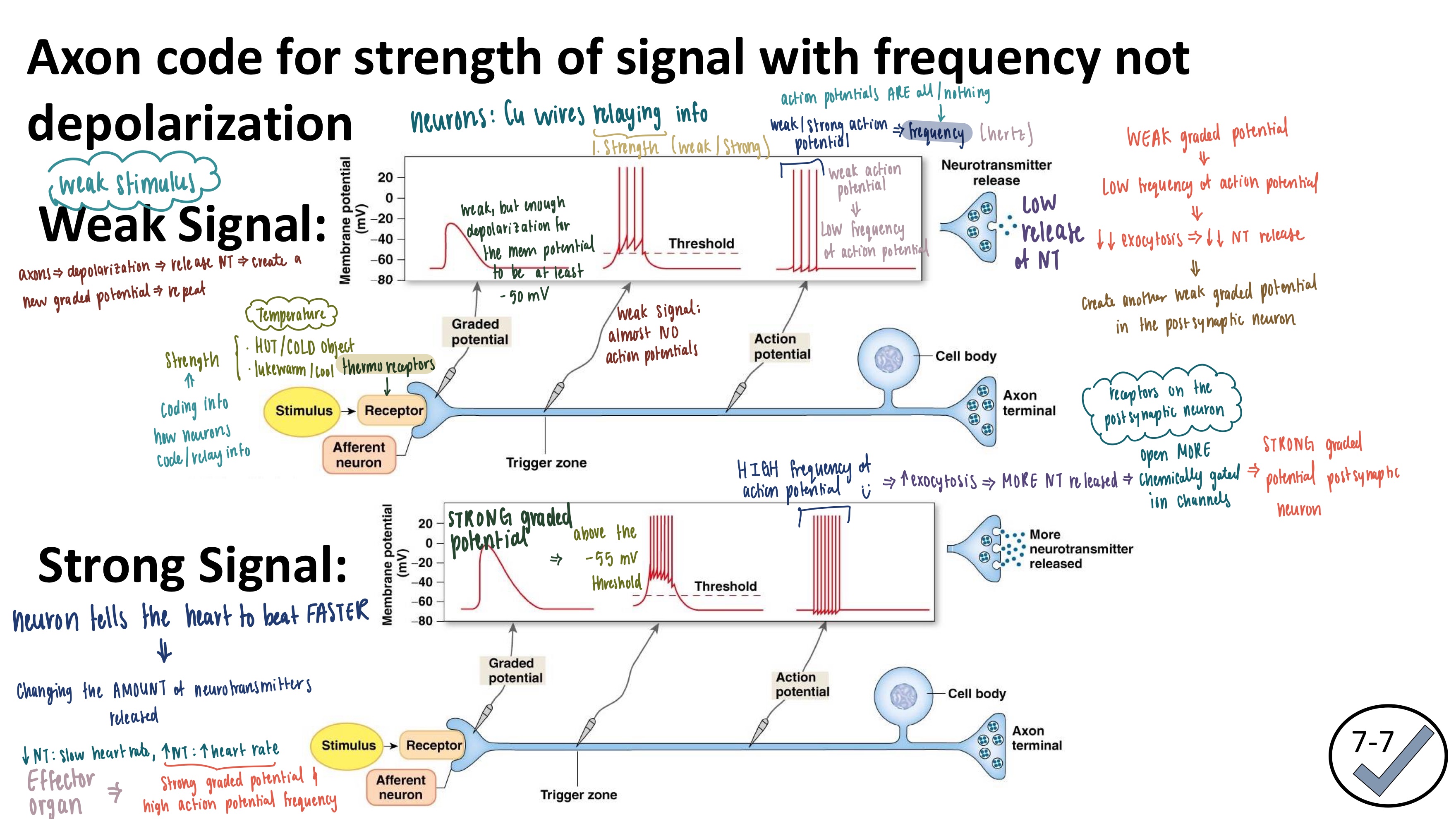
Describe how a neurotransmitter, once released from the axon terminal, can trigger (or prevent) a graded potential in the postsynaptic neuron.
Trigger a graded potential: Neurotransmitter DEPOLARIZES the postsynaptic neuron
Inhibited/prevent a graded potential: neurotransmitter HYPERPOLARIZES the membrane potential of the postsynaptic neuron
shifted the membrane potential so it won’t reach the -50 mV threshold
Bind/open K+ channels
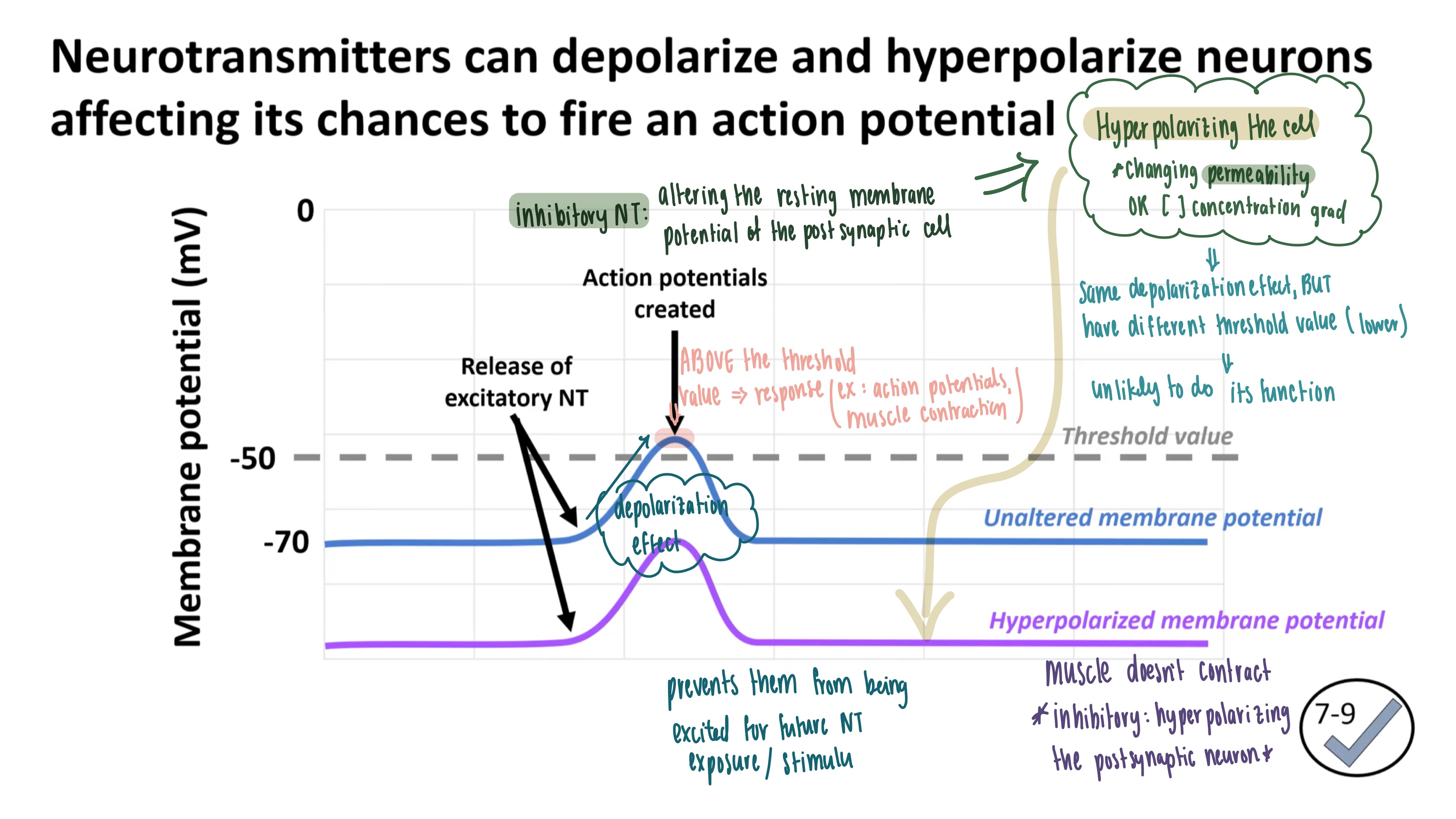
What does it mean for a neurotransmitter to be excitatory or inhibitory?
Excitatory: Depolarizes the neuron
Inhibit: Hyperpolarize the neuron
How can the effect of Acetylcholine (ACh) and Norepinephrine (NE) vary between excitatory and inhibitory in the body?
Acetylcholine (ACh): binds to K+ ion → opens them → decreases the membrane potential → hyperpolarizes the cell → inhibits the neuron
Norepinephrine (NE): binds to Na+ ions → opens them → INCREASES membrane potential → depolarizes the cell → excites the neuron
Excitatory & inhibitory effect vary with the types of receptors
Adrenergic receptors (alpha & beta)